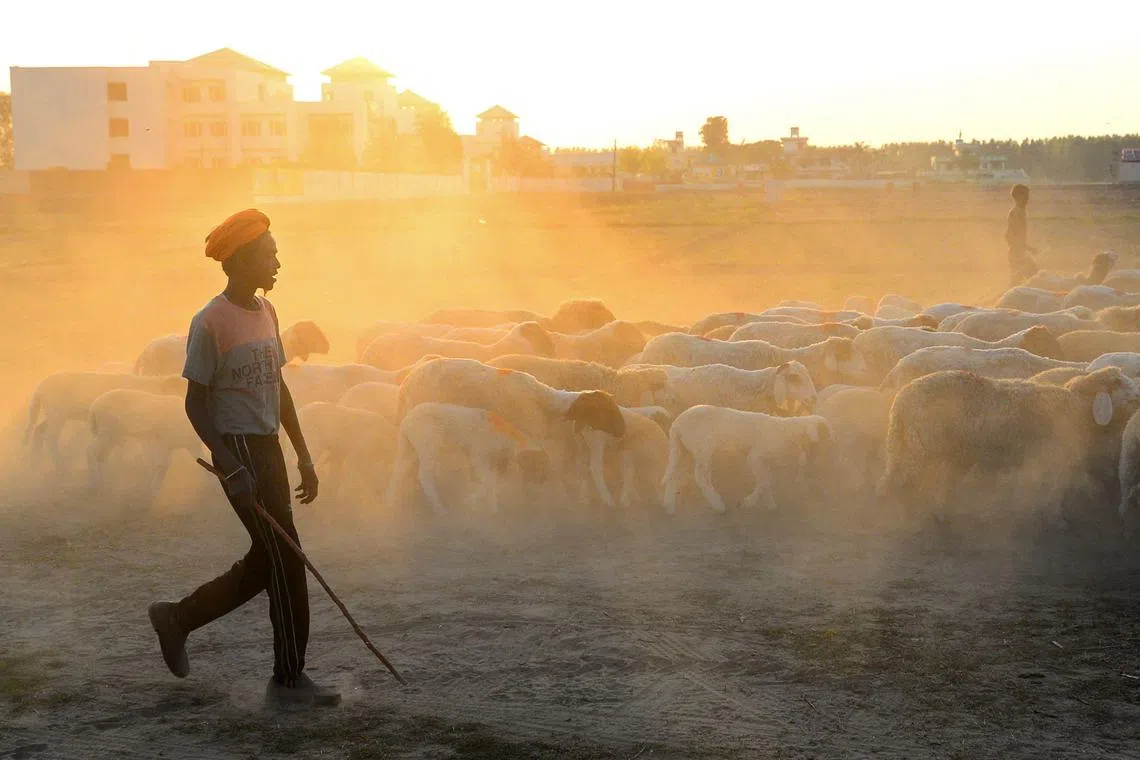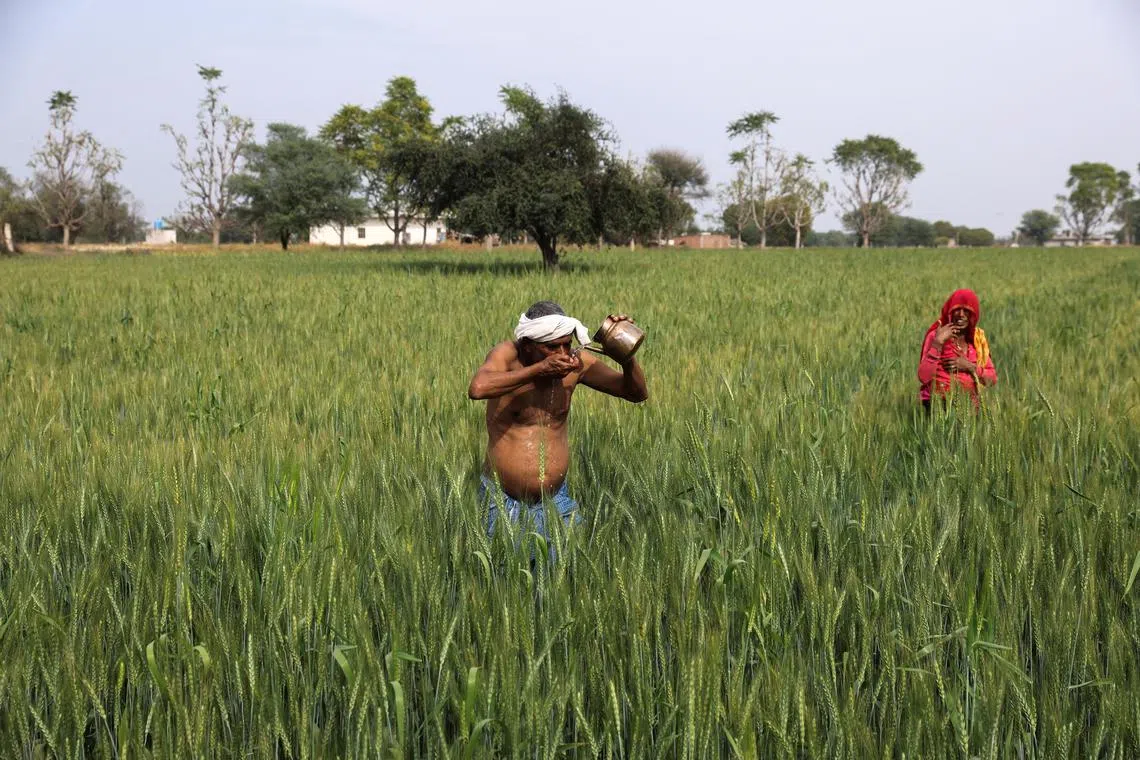Concerns in India over anticipated high summer temperatures and impact on agriculture
Sign up now: Get insights on Asia's fast-moving developments

Monthly maximum temperatures for March are likely to be above normal across most parts of the country.
PHOTO: AFP
Follow topic:
NEW DELHI - Concern has begun mounting in India ahead of a predicted hotter-than-usual summer, especially around the impact that high temperatures could have on the country’s agricultural output and millions of its outdoor workers.
February 2023 was judged the hottest on record for the country since 1901, when the India Meteorological Department (IMD) started keeping weather records. The average maximum temperature for February was 29.66 deg C, surpassing 29.48 deg C in 2016.
Worse may be in store, though, with the IMD saying monthly maximum temperatures for March are likely to be above normal across most parts of the country.
It has also predicted an “enhanced probability” of heatwaves from March to May
“The month of March is going to be hotter than normal, possibly much hotter,” said Mr G. P. Sharma, president of meteorology and climate change at Skymet Weather Services, a private Indian company that provides weather forecasting services.
He told The Straits Times that mild winter rains had led to a rainfall deficit across many parts of India, “setting the pace for the upcoming (dry and hot) season”.
March 2022 was recorded as the hottest since 1901, with the average maximum temperature touching 33.1 deg C. The previous high was 33.09 deg C for March 2010.
Ominous signs are already here.
Heatwave conditions in the coastal western state of Goa, where maximum temperatures have hovered between 37 deg C and 39 deg C, forced the local administration to take the unprecedented step of asking schools to shut by noon on Thursday and Friday.
The early high temperatures could also adversely affect the yield of India’s upcoming agricultural harvest, especially that of wheat. The crop is sensitive to high heat, which can shrivel its grains.
“The industry is definitely worried about a potential fall in wheat production that could spike prices,” said Mr Rahul Chauhan, a commodity analyst at IGrain India.
India grows wheat once a year during the winter or rabi season, with planting in October and November, and harvesting from March.
A heatwave had cut India’s wheat production in 2022, compelling the world’s second-largest producer to ban commercial exports in May that year.
This was done to ensure adequate domestic supply by preventing overseas shipments amid a surge in demand abroad after Russia’s invasion of Ukraine, a major wheat exporter.
Mr Chauhan told The Straits Times that unseasonal rain since the start of March along with an abnormal rise in temperatures could cut wheat output, forcing India to keep the lid on wheat exports as the government seeks to replenish its stocks and cool domestic prices. “I don’t see the government permitting commercial wheat exports for the 2023-24 financial year,” he added.
The government-run Institute of Wheat and Barley Research issued an advisory in February, listing precautions farmers could take to protect their wheat crop.
Other standing crops such as chickpea, as well as horticultural produce, including mandarins, lychees and mangoes, are also at risk from the early onset of heat.
A reduced agricultural yield could stall India’s rural economic recovery and add to inflationary pressures.

Farmer Madhulal Meena, 60, drinks water in a wheat field near Jaipur, India, on Feb 24, 2023.
REUTERS
“Prices for wheat, which were expected to decline, will continue to remain elevated, keeping upward pressure on food inflation,” said Mr Pushan Sharma, director of research at CRISIL Market Intelligence & Analytics.
Prices of staples, such as bread and biscuits, which have reflected an upward trend, will remain at their higher levels, he added.
The average price of wheat flour rose by 25 per cent between 2018 and 2022, jumping from 24.2 rupees (40 Singapore cents) per kg to 30.15 rupees.
Vegetable prices, which declined markedly in recent months and acted as a cushion to overall food inflation, are also likely to increase this summer season, according to a March 6 note from Oxford Economics.
The situation could worsen later in the year, with the growing possibility of an El Nino weather pattern setting in
El Nino is a climatic phenomenon where rising surface sea temperatures off the west coast of the Americas affect the monsoon winds and create drought conditions in South Asia and Australasia.
Around 50 per cent of the cropped area in India depends on monsoon rainfall for irrigation, and El Nino years have been associated with both a fall in agricultural production and reduced gross domestic product growth.
Ways to beat the heat
To reduce heat-related stress, India’s National Disaster Management Authority (NDMA) has suggested to various states measures including rescheduling school timings as well as working hours for outdoor workers.
In a letter sent on March 4, the NDMA also recommended setting up air-cooled spaces at temples and public buildings.
Since the India Meteorological Department’s Feb 28 warning indicating an “enhanced probability” of heat waves from March to May, there has been a flurry of government activity to reinforce preparedness to handle high summer temperatures.
On March 6, Prime Minister Narendra Modi chaired a meeting that focused on efforts to prepare for potential heat-related disasters and also assess mitigation measures.
This came after the government warned in February that temperatures had already touched an “unusual high” in some places, with “substantial deviations” from normal temperatures for this time of the year.
Mr Anup Kumar Srivastava, a senior consultant at the NDMA, said many states have updated their heat action plans (HAPs) and drafted their specific set of dos and don’ts.
“States have also begun taking measures such as supplying drinking water at vulnerable areas where water supply is scarce,” he told ST, warning that both the intensity and duration of heat waves are likely to increase this time.
Of the 23 heat-prone states, the number of those with dedicated HAPs has, however, remained at 19 since last year.
According to official data, India reported 30 heat wave deaths in 2022, but this is widely believed to be an underestimate.
Advisories issued under these plans have also proved difficult to implement, even in Ahmedabad, South Asia’s first city to develop a HAP in 2013.
“The administration here tells us these directions are an advisory and therefore cannot be enforced. Nor can they penalise those who do not follow them,” said Mr Mahesh Gajera, a programme manager at the Aajeevika Bureau.
Aajeevika is a collective that works for the well-being of migrant workers, including by lobbying employers of such workers to alleviate heat-related stress.
While acknowledging sporadic efforts, such as the provision of drinking water and shade, he told ST these steps had to be formalised as well as sustained throughout the summer.


